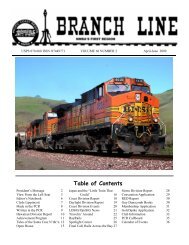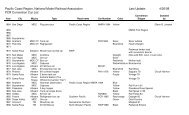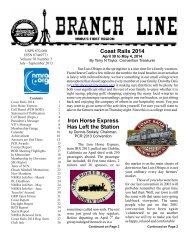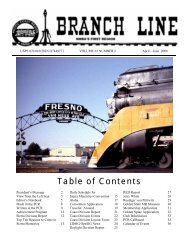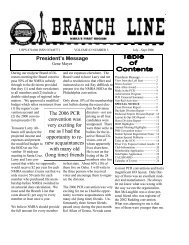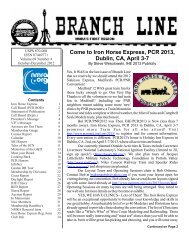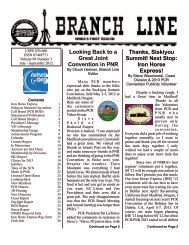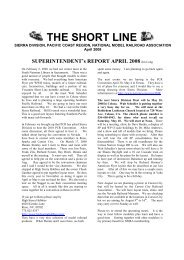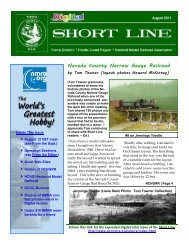You also want an ePaper? Increase the reach of your titles
YUMPU automatically turns print PDFs into web optimized ePapers that Google loves.
<strong>All</strong> <strong>About</strong> <strong>YARD</strong> <strong>LIMITS</strong>
A Bongo Brothers Production<br />
• Steve Gust – Clay & Mud Point RR<br />
• Rick Kang – Vegetable Northern<br />
Transportation Company
Mini-lesson goals:<br />
1. What are and aren’t Yard Limits?<br />
2. Prototype use of Yard Limits<br />
3. Model use of Yard Limits
Barney Secord’s Grand Valley
Where is<br />
1. MAIN TRACK?<br />
2. SIDING?<br />
3. Auxiliary tracks?<br />
4. <strong>YARD</strong> <strong>LIMITS</strong>?
• Main Track<br />
• Siding<br />
• Aux. Tracks<br />
• Yard Limits<br />
Main Track
UCOR Definitions<br />
• Yard<br />
A system of tracks, other than main tracks and<br />
sidings, used for making up trains, storing of<br />
cars and for other purposes.<br />
• Yard Limits<br />
A portion of the main track, designated by yard<br />
limit signs and timetable, train order Form T, or<br />
track bulletin, which trains and engines may<br />
use as prescribed by Rule 93.
<strong>YARD</strong> <strong>LIMITS</strong> are a section<br />
of MAIN TRACK!<br />
(Main Track is primary track connecting stations<br />
and through stations, upon which trains move at<br />
track speed)<br />
• Between the “forked sticks” signs.<br />
• Defined by MP locations in Timetable.<br />
• Where movements are governed by<br />
RULE 93<br />
• Where ALL movements must move at<br />
RESTRICTED SPEED (unless block<br />
signal protection present)
Essence of Rule 93:<br />
1. Trains and Engines<br />
are authorized to<br />
occupy and move<br />
on MAIN TRACK<br />
2. Must CLEAR times<br />
of FIRST CLASS<br />
TRAINS<br />
3. Are relieved of flag<br />
protection against<br />
other trains and<br />
engines
City of New Orleans First Class Train making<br />
track speed on Main Track<br />
in Memphis YL if signal was green
What if Dark Territory (no<br />
signals), or yellow signal?<br />
• PROTECTION due to compliance with<br />
RESTRICTED SPEED:<br />
moving prepared to stop within half the<br />
range of vision short of car, engine,<br />
obstruction, broken rail, switch not<br />
properly lined, and at no more than (20)<br />
MPH
YIKES, We’ve created a<br />
FREE FOR ALL!<br />
• Relax, usually works very well.
Who’s in charge?<br />
• NOBODY!<br />
• Well, OK, there may<br />
be a <strong>YARD</strong>MASTER<br />
or AGENT<br />
• Generally, the<br />
Conductor or Switch<br />
Crew Foreman of<br />
FIRST TRAIN<br />
THERE.
WHY DO THIS?<br />
• At locations where multiple trains and<br />
engines work primarily within auxiliary<br />
trackage yet require short sections of<br />
main track to do their work,<br />
• LET THE CREWS ON THE SPOT<br />
READILY COLLABORATE!<br />
• Free the Dispatcher of having to issue<br />
numerous rapidly changing<br />
orders/warrants!
Local prototype examples:<br />
• Main track through Medford: several<br />
Switchers working industries and G<br />
Yard<br />
• Main track Medford to Tolo (junction<br />
with White City Branch) several Road<br />
Switchers operate between Medford<br />
and White City<br />
• Main track Ashland to Bellevue,<br />
GP Turn switches Bellevue mill<br />
• Sage Hen on Modoc Subdiv, relief of<br />
flag protection, rev. move cut helper
Any downsides?<br />
• YES.<br />
1. Through trains may get delayed if locals<br />
or switchers elect to work in their face.<br />
2. Control of railroad is de-centralized,<br />
potential effects up and down the pike.<br />
PLAN CAREFULLY WHERE YOU WANT<br />
TO ESTABLISH <strong>YARD</strong> <strong>LIMITS</strong>.
Why do this on the model?
Same reasons!<br />
Put “forked sticks” along main track at<br />
endpoint terminals, midpoint terminal, or<br />
at adjacent yards (generally beyond<br />
fouling points). CTC, DTC, TWC, TTTO<br />
authority starts at the <strong>YARD</strong> BOARD.<br />
1. Relieve Dispatcher of micro managing.<br />
2. Foster local collaboration at terminal<br />
3. Plus, add another prototypical aspect<br />
(that DCC makes readily feasible)
Some suggested model<br />
YL boundaries (main track)<br />
• Trainlength beyond initial switches at a station<br />
or yard, extending away from station<br />
• Between siding switches at a station and<br />
extending to adjacent station, probably<br />
encompassing main track and beyond, there.<br />
• Adjacent to END/BEGIN CTC or END/BEGIN<br />
INTERLOCKING limits (opposite the controlled<br />
signal)<br />
• At beginning/end of where Train Order, DTC,<br />
or TWC authority exists
Examples<br />
• YL – DTC block – DTC block – YL<br />
• TWC – YL – TWC – YL<br />
• YL – CTC – INTER – YL – CTC - YL<br />
• Ask us about the anomaly at Gazelle:<br />
starting at east end, in Train Order<br />
territory: YL sign, east siding switch, west<br />
siding switch, YL sign opposite the Begin<br />
CTC sign on Absolute Signal. How did<br />
we issue orders to “legally” make meets<br />
at Gazelle?



